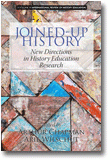
Joined-up History
New Directions in History Education Research
Edited by:
Arthur Chapman, University College London
Arie Wilschut, Amsterdam University of Professional Education
A volume in the series: International Review of History Education. Editor(s): Arthur Chapman, University College London. Arie Wilschut, Amsterdam University of Professional Education. Stuart J. Foster, University of London.
Published 2015
Debates about the identity of school history and about the nature and purpose of the learning that does, can and should take place in history classrooms continue in many countries around the world. At issue, in many of these debates, beyond the concerns about history and national identity, are often unaddressed questions about the role and inter-relationship of historical knowledge and historical understanding in historical learning.
Research on historical thinking is on-going and a complex tradition of enquiry has developed across national borders in the last 30 years, focusing, in particular on developing students understanding of historical meta-concepts such as ‘evidence’ and ‘causation’. There has been comparatively little focus, however, on the historical content that students study, on how they study it and on how mastery of historical content contributes to students overall picture of a historical past.
This volume gathers together recent research and theorising from around the world on key issues central to historical learning and instruction. What sense do students make of the history that they are taught? Are students able to organise historical knowledge in order to form large scale representations of the past and what difficulties can children face in doing so? What are the relationships that obtain between history as an academic discipline, as practised in universities, and history as a subject taught in schools? What can research tell us about the effects of instructional strategies that aim to help students ‘join up’ what they learn in class into meaningful historical knowledge and understanding?
CONTENTS
Series Editors’ Introduction. Introduction, Arthur Chapman and Arie Wilschut. History and Temporal Orientation: The Views of Portuguese-Speaking Students, Isabel Barca. Disciplinary and Conceptual Understanding Related to the Study of History by Students Aged 12 to 13 Years, Félix Bouvier and Sandra Chiasson Desjardins. Only Connect: How Students Form Connections Within and Between Historical Narratives, Frances Blow, Rick Rogers, Denis Shemilt, and Claire Smith. Teachers Teaching History in Spain: Aims, Perceptions, and Practice on Second-Order Concepts, Lis Cercadillo. Dialogue Between the Source and the Historian’s View Occurs: Mapping Change in Student Thinking About Historical Accounts in Expert and Peer Online Discussion, Arthur Chapman and Emily Goldsmith. Narrating Continuity: Investigating Knowledge and Narrative in a Lower Secondary School Study of 16th-Century Change, Christine Counsell and Steve Mastin. Good History Teaching in Switzerland: Principles, Findings, Suggestions, Peter Gautschi. Small Country, Great Ambitions: Prospective Teachers’ Narratives and Knowledge About Dutch History, Marc Kropman, Carla Van Boxtel, and Jannet Van Drie. Understanding the Nature of History: Students’ Tacit Epistemology in Dealing With Conflicting Historical Narratives, Matthias Martens. A Brave New World: History Education Reform in the Greek-Cypriot Educational System, Lukas Perikleous. English Students’ Inferences About Motives From Historical Sources: How Far Do They Draw on Contextual Knowledge? Elisabeth Pickles. Looking for History, Peter Seixas. Making the Constructed Nature of History Visible: Flemish Secondary History Education Through the Lens of Written Examinations, Karel Van Nieuwenhuyse, Kaat Wils, Geraldine Clarebout, Greet Draye, and Lieven Verschaffel. Testing Frame of Reference Knowledge in National Examinations: Report on an Experiment in the Netherlands, Arie Wilschut.
-
Paperback978-1-68123-032-0
Web price: $45.04 (Reg. 52.99)
-
Hardcover978-1-68123-033-7
Web price: $80.74 (Reg. 94.99)
- eBook978-1-68123-034-4

-
 (Re)Envisioning Social Studies Education Research
Current Epistemological and Methodological Expansions, Deconstructions, and Creations
(Re)Envisioning Social Studies Education Research
Current Epistemological and Methodological Expansions, Deconstructions, and Creations
-
 Contemporary Public Debates Over History Education
Contemporary Public Debates Over History Education
-
 History Education and Historical Inquiry
History Education and Historical Inquiry
-
 History Education and the Construction of National Identities
History Education and the Construction of National Identities
-
 National History Standards
The Problem of the Canon and the Future of Teaching History
National History Standards
The Problem of the Canon and the Future of Teaching History
-
 The Colonial Past in History Textbooks
Historical and Social Psychological Perspectives
The Colonial Past in History Textbooks
Historical and Social Psychological Perspectives
-
 The Handbook for Aspiring Higher Education Leaders
The Handbook for Aspiring Higher Education Leaders

